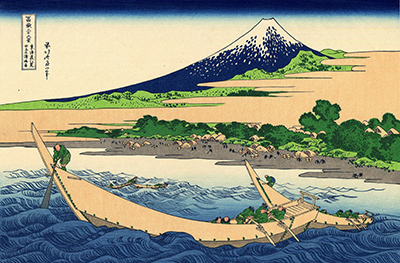In Tago Bay near Ejiri on the Tōkaidō, Hokusai employs a romantic framing of Mount Fuji, snow-capped and receding from both cloud and land, towering over Tago bay. The junks at sail in the turbulent waters provide a juxtaposition to Fuji's similarly powerful, but static, presence.
The oarsman of the junk are depicted as strained at work, signifying the strength of Suruga bay's waters. Meanwhile, the shoreline is dotted with activity from fishermen and workers carrying baskets of salt for kilns along the beach. This act of balancing between foreground and background was a perspective Hokusai often employed as a means of counterpoise. The method of production of this print involved Hokusai hand-drawing the scene and then transferring it, with the help of woodcutters, onto a wooden block for printing. The block is covered in ink and then impressed upon a sheet of fine art paper. To achieve the rich variety of colour present in Tago Bay near Ejiri on the Tōkaidō, numerous blocks of coloured ink are created and combined in use.
During the period of Tago Bay near Ejiri on the Tōkaidō's publication, views of Fuji had become an important trope for Japan's artists and the popular cultural imagination. Fuji was heralded as a symbol of national heritage, timelessness and tradition. In Japanese folk culture, Fuji has continually influenced writers and artists for its association with spiritual ritual, religion and the immortality of "the Gods" and deities that are said to have reside there. Apart from Hokusai, other famous Ukiyo-e artists drawing from Fuji as an influence include Utagawa Hiroshige (1797 - 1858), Utagawa Kunisada (1786 – 1865) and Eizan Kikugawa (1787 - 1867).
Katsushika Hokusai’s (1760 - 1849) Shore of Tago Bay near Ejiri on the Tōkaidō (Tōkaidō Ejiri tago-no-ura), is a woodcut-print on paper produced for the famed series Thirty-Six Views of Fuji (Fugaku Sanjūrokkei). This woodcut was first printed around 1830, during a period in which Hokusai achieved significant and sustained success in Japanese print culture, as an esteemed and venerable master of the Ukiyo-e method of printing (Pictures of a floating world). The style and form of the print is typical of Hokusai and Ukiyo-e printing, with intricate colour detail and a dramatic depiction of everyday life within a natural setting.




